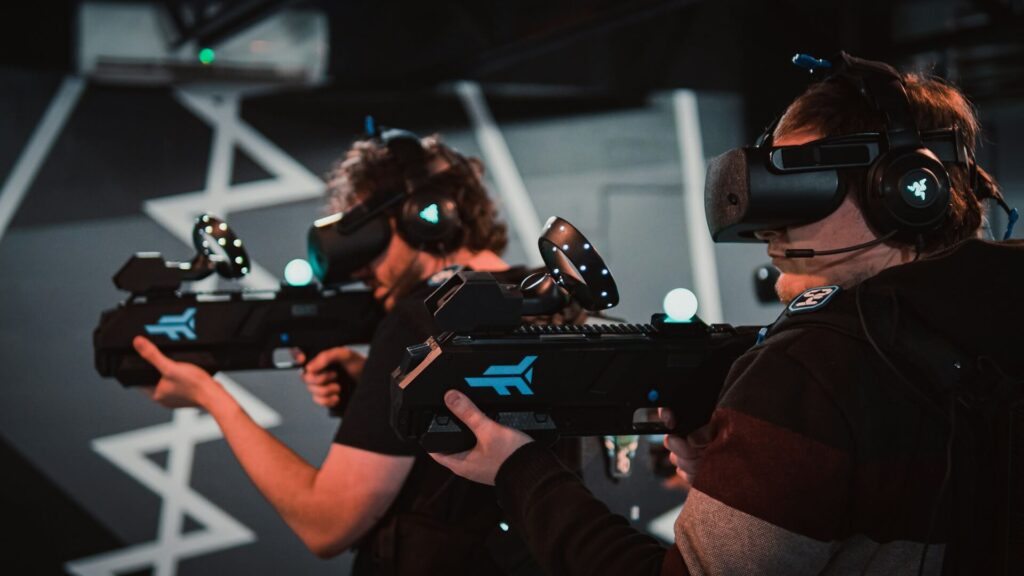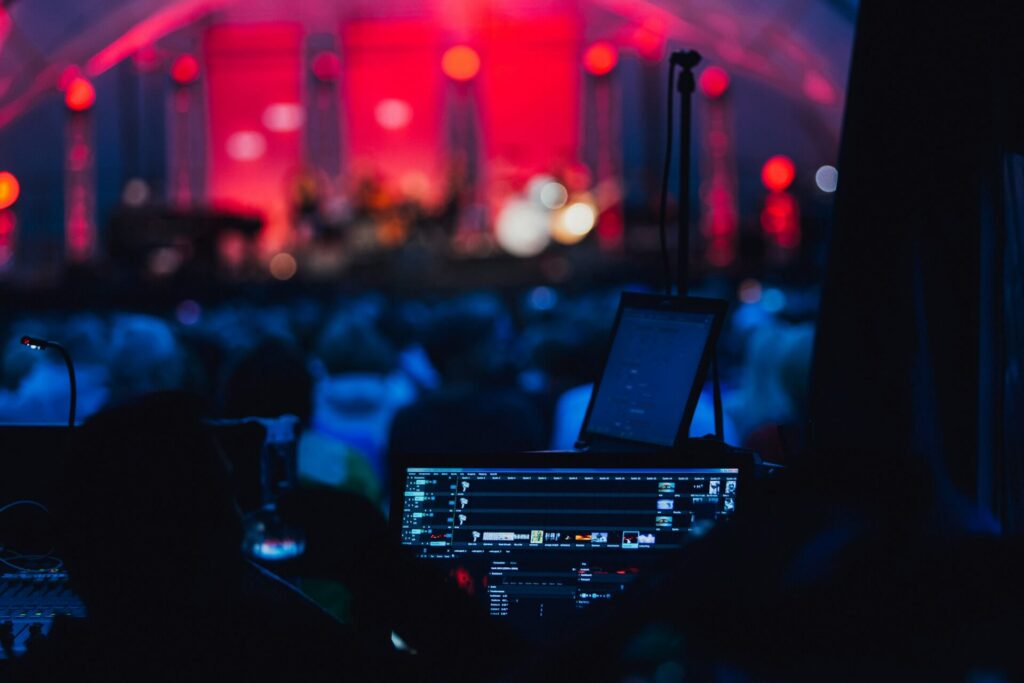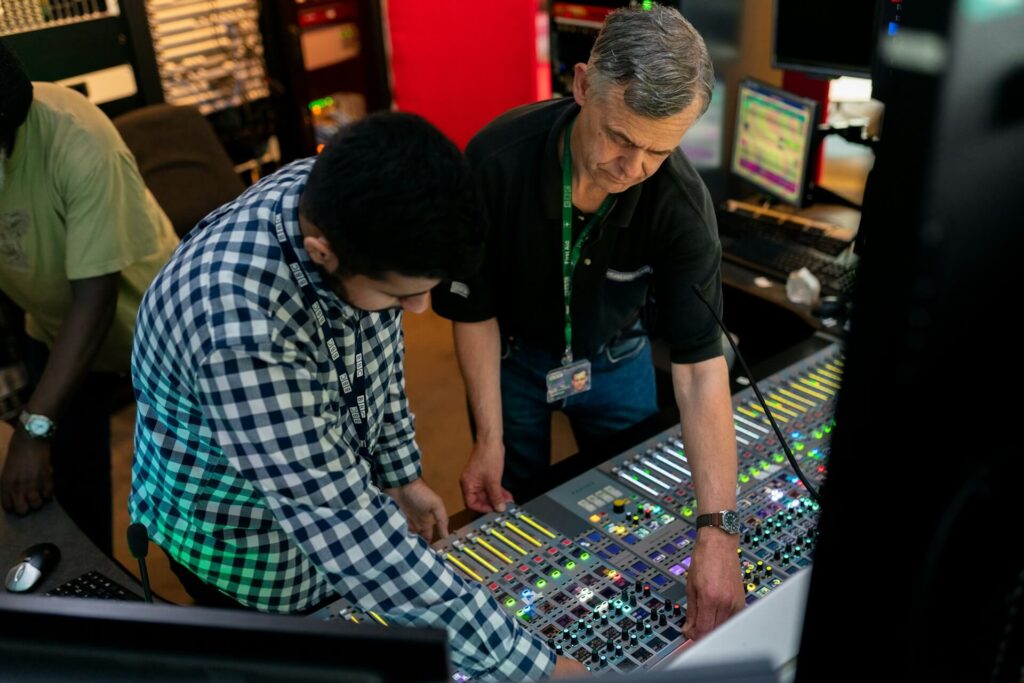Welcome to the immersive world of gaming, where every beep, clash, and whisper is more than just a sound—it’s a vital part of your adventure.
In this blog, we’re diving into the often-overlooked yet crucial world of sound effects in video games. From the nostalgic chirps in classic arcade games to the rich, enveloping soundscapes of today’s blockbusters, sound effects have come a long way. They do more than just please our ears; they bring game worlds to life, guide our gameplay, and even tug at our emotions.
So, grab your headphones, and let’s explore how these sounds shape our gaming experiences, making every session uniquely memorable.

Types of Sound Effects in Games
When we play video games, it’s not just the graphics that catch our attention; the sounds we hear play a big part too. Let’s break down the different types of sound effects you might come across in games:
- Ambient Sounds: These are the background noises that give a game’s environment its atmosphere. Think of the chirping birds in a forest scene or the busy chatter in a city setting. Ambient sounds are like the canvas for the rest of the game’s audio—they set the tone and feel of the world you’re exploring.
- Character Sounds: Character sounds are all about bringing the personalities in the game to life. This includes the voices of characters when they talk, grunt, or shout during the game. It also covers the sound of their movements, like footsteps, jumps, or the rustle of clothing. These sounds help us connect with the characters, making them feel more real.
- Interface Sounds: These are the sounds you hear when you interact with the game’s menu or user interface. Think of the click when you select an option or the small beep when a new message pops up. Interface sounds may seem small, but they’re crucial for making the game feel responsive to your actions.
- Environmental Sounds: Different from ambient sounds, environmental sounds are specific noises linked to objects or events in the game world. This could be the sound of doors opening, the crash of a falling tree, or the splash of water. These sounds help to make the game environment feel alive and interactive.
- Action Sounds: Action sounds are the dramatic effects that accompany the key actions in the game, like the swing of a sword, the firing of a gun, or the explosion of a bomb. These sounds add excitement and intensity to the gameplay, making every action feel impactful.
- Feedback Sounds: Feedback sounds let you know how you’re doing in the game. This includes the sound of collecting items, the ring of coins, or the buzz of a wrong answer. They provide instant feedback on your actions, helping you understand the game better.
Each type of sound plays its unique role, contributing to the overall experience of the game. Together, they create a rich tapestry of audio that makes games more engaging and enjoyable.
Here’s an interesting video that you can watch on YouTube…
Sound Effects and Game Immersion
Imagine playing a game with your eyes closed. It’s the surrounding sounds that make you feel like you’re truly inside the game world. This is all about game immersion, where sound effects play a starring role. Let’s see how they do it:
- Creating a Believable World: Good sound effects can make a game world feel real. When you hear the crunch of leaves underfoot in a forest, or the echo of footsteps in a hall, it’s easier to believe you’re actually there. These sounds fill in the details of the game world around you.
- Enhancing the Mood: Sounds also set the mood of the game. For example, a spooky soundtrack with creaking sounds can make a horror game feel even scarier. On the other hand, lively music and cheerful chatter can make a game world feel bustling and lively.
- Guiding the Player: Sound effects can also act as guides. The sound of a monster growling in the distance tells you where to be careful. A ringing bell or a sudden crash sound can alert you to something important happening. These audio cues help players navigate the game world.
- Making Actions Feel Satisfying: The sound of a sword clashing or a car engine revving up adds weight to your actions in the game. It makes every move you make feel important and satisfying, adding to the enjoyment of the game.
- Connecting Emotionally: Sounds can pull at your heartstrings, too. The sad melody that plays during a tragic scene in the game can make you feel the emotions more deeply. It’s like the soundtrack of a movie that adds depth to the story.
- Building Tension and Excitement: In action-packed moments, the pace of the music and the intensity of sound effects build up tension. The faster heartbeat sounds, the loud explosions, and the rapid gunfire sounds make your pulse race, pulling you further into the game.

Sound effects are not just about hearing; they’re about feeling.
They turn a game from a simple visual experience into a rich, immersive journey that engages all your senses. Good sound design can transport players from their living room into the heart of a game’s world, making every moment in the game more real and memorable.
Technical Aspects of Game Sound Design
Sound design in games is like a behind-the-scenes magic show. It’s where technology and creativity meet to create the sounds that bring games to life. Let’s look at some key parts of this process:
- Recording and Creating Sounds: First, sound designers either record real-life sounds or create them using computers. For example, the roar of a dragon might be made from a mix of animal noises, or the sound of footsteps might be recorded in a studio.
- Editing and Mixing: Once the sounds are recorded, they’re edited to fit the game. This can mean cutting them to the right length, adjusting their loudness, or adding effects to make them sound just right.
- Implementation in the Game: After the sounds are ready, they need to be put into the game. This involves coding and using special software so that the sounds play at the right time and place in the game. For example, making sure a door creaks exactly when a player opens it.
- Balancing and Testing: Getting the balance right is important. This means making sure no sound is too loud or too quiet compared to others. Testing is done to check how the sounds work in the game, often leading to adjustments to make sure everything sounds perfect.
- Dynamic Audio: In many modern games, sounds change based on what’s happening in the game. For instance, the sound of rain might get louder as a player moves outdoors. This dynamic audio makes the game world feel more real and responsive.
In short, game sound design is a mix of art and science. Sound designers use their skills and technology to create an audio world that makes games more engaging and fun to play.
Innovative Uses of Sound in Gaming
Over the years, some games have pushed the boundaries of what we expect from sound design, using audio in fresh and exciting ways. Here are a few examples of how innovative sound has transformed gaming experiences:
- Environmental Interaction: In games like “The Legend of Zelda: Breath of the Wild,” the sound isn’t just for the atmosphere; it’s a key part of gameplay. You can hear the direction of approaching enemies or the rustle of leaves indicating hidden items.
- Narrative and Storytelling: Some games use sound to tell a story. In “Hellblade: Senua’s Sacrifice,” the protagonist experiences auditory hallucinations. Players hear voices from different angles, thanks to binaural audio, making the experience intensely immersive and emotionally impactful.
- Game Mechanics: Sound can also be a central gameplay mechanic. In “A Blind Legend,” the entire game is audio-based, designed for both visually impaired and sighted players. Players rely on sound cues and 3D audio environments to navigate and combat enemies, offering a unique gaming experience emphasising auditory skills over visual cues.
- Enhancing Realism: Games like the “Battlefield” series have used sound to enhance realism. The games feature dynamic soundscapes where the intensity and nature of sound effects change depending on the environment, distance, and even the materials between the player and the sound source.
- Emotional Connections: In “Journey,” the sound design is closely tied to the player’s emotional journey. The music dynamically adjusts to player actions and interactions, creating a personalized and deeply emotional experience.
These examples demonstrate how sound in gaming isn’t just about background music or effects. It’s a versatile tool that can enhance storytelling, create immersive environments, form unique gameplay mechanics, and connect with players on a deeper level.

The Challenges of Sound Design in Gaming
Creating sound for video games is an art, but it comes with its own set of challenges. Sound designers face several hurdles to ensure that the audio in games enhances the player’s experience. Here are some key challenges they often encounter:
- Balancing Realism with Clarity: One of the toughest parts of game sound design is striking a balance between making sounds realistic and ensuring they are clear and helpful to the player. For example, in a realistic setting, a gunshot might be deafeningly loud, but in a game, it needs to be loud enough to be realistic without overpowering other important audio cues.
- Dealing with Repetitive Sounds: Games often involve repetitive actions, which can lead to repetitive sounds. Sound designers have to be creative in making these sounds pleasing (or at least not annoying) even after the hundredth time you hear them. This might involve subtle variations in the sounds or designing sounds that are easy on the ears.
- Creating Dynamic Audio Environments: As players move through different game environments, the sound needs to change to reflect their surroundings. This dynamic audio is challenging to create. It requires not just different sounds for different areas but also sounds that change in response to player actions and game events.
- Ensuring Accessibility: Sound designers also need to consider players with hearing impairments or other disabilities. This might involve creating visual cues for important sounds or designing games that don’t rely solely on audio cues for critical game information.
- Technical Constraints and Optimization: Game sound designers often work with technical limitations like file size restrictions and the need for sounds to work on various hardware. They must optimize sound quality while ensuring it doesn’t slow down or interfere with the game’s performance.
- Creating a Unified Audio Experience: Finally, sound designers must ensure that all the different types of sounds—from background music to character voices to sound effects—work together harmoniously. This unified audio experience is crucial for maintaining immersion and delivering a cohesive game experience.
Overcoming these challenges requires a mix of technical skill, creativity, and a deep understanding of how sound affects the gaming experience. It’s a complex task, but when done right, it makes games much more engaging and enjoyable.

Future Trends in Game Audio
The world of game audio is continually evolving, with new technologies and ideas constantly emerging. Let’s explore some of the exciting trends and advancements that are shaping the future of sound in gaming:
- 3D Audio and Spatial Sound: One of the biggest trends is the move towards 3D audio and spatial sound. This technology allows players to hear sounds more realistically, coming from all directions, just like in real life. It greatly enhances immersion, making you feel like you’re truly inside the game world. More games are starting to use this technology, especially with the rise of virtual reality gaming.
- Interactive Music: Music that changes based on player actions or game events is becoming more common. This interactive music can adapt to the intensity of gameplay, shift with different story arcs, or even change based on player choices. It makes the gaming experience more dynamic and personalized.
- Artificial Intelligence in Sound Design: AI is starting to play a role in in-game audio. AI algorithms can be used to create sound effects on the fly or to modify sounds based on specific game scenarios. This can lead to more dynamic and responsive audio environments, as well as reduce the workload for sound designers.
- Real-Time Sound Modification: Games are increasingly using real-time sound modification. This means the game can alter sounds on the spot based on what’s happening. For example, the echo in a cave might change as you move through it, or the sound of the rain might get muffled when you go indoors.
- Enhanced Voice Interaction: With voice recognition technology improving, we’re likely to see more games that use voice interactions. Players might be able to talk to characters in the game or control certain aspects of the game with their voices, adding a new layer of interaction.
- Augmented Reality Sounds: As augmented reality (AR) games become more popular, there’s a growing interest in AR sound design. This involves creating audio that blends seamlessly with the real world, making the AR experience more convincing and immersive.
- Focus on Accessibility: There’s also a growing focus on making game audio more accessible. This includes developing better subtitles and visual indicators for players with hearing impairments and designing audio that’s more inclusive for all players.
These trends show that the future of game audio is all about creating more immersive, interactive, and responsive soundscapes. As technology advances, the line between game sounds and the real world continues to blur, making gaming a more exciting and immersive experience.
Conclusion
As we’ve explored, the challenges of sound design are many, but they are met with creativity and innovation, leading to exciting developments in in-game audio. The future of game audio, with trends like 3D spatial sound, interactive music, and AI integration, promises even more immersive and interactive gaming experiences.
The art of sound in games is a testament to the incredible skill and imagination of sound designers. It’s a reminder of how essential sound is to our gaming experiences and how it will continue to shape the worlds we dive into. As we move forward, it’s clear that the sounds of gaming will only get richer, more nuanced, and more integral to the gaming journey.
Leave a Reply